What Is Digital Transformation? Complex Guide for 2022
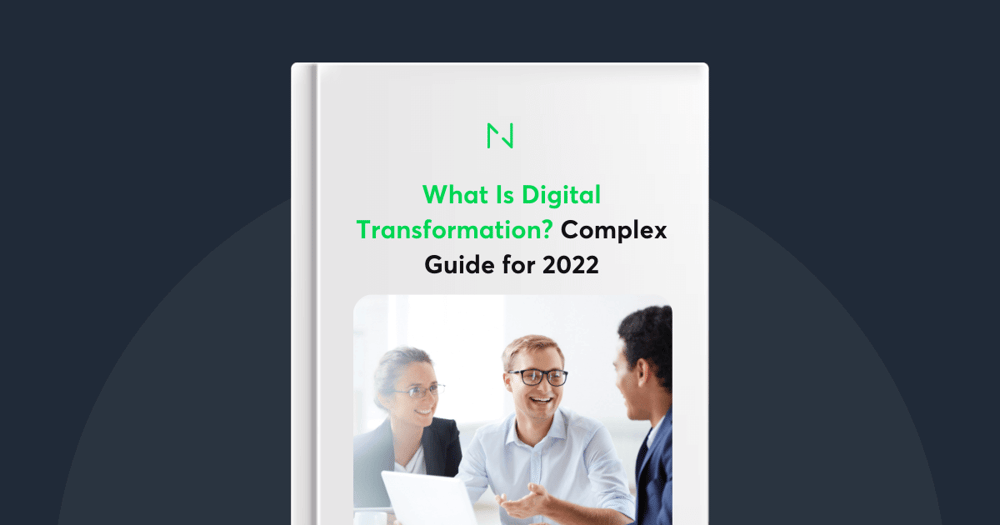
Introduction
Contents
In this guide, we’re going to discuss what digital transformation means for business today, why it’s important, and share a selection of digital transformation projects that have been completed successfully. Let’s begin.
The digital tech spending is booming
Studies show that global digital transformation technology investments are forecast to reach $2.3 trillion by 2023, becoming a majority share of total IT budgets in enterprises. According to Craig Simpson, research manager at IDC's Customer Insights and Analysis Group:
We are approaching an important milestone in digital transformation investment with our forecast showing its share of total worldwide technology investment hitting 53% in 2023.
What is digital transformation?
While the term has been on everyone’s lips for many years now, you might be wondering – what does digital transformation really mean?
We’ll start off by taking a look at how the process is defined by some of the top global organizations, including the World Economic Forum and Accenture. Next, we’ll review the differences between ‘digital transformation’, ‘digitization’, and ‘digitalization’ to ensure you’re using them in the right context and that you understand what introducing them entails for businesses.
Digital transformation – definition
In a report published by The Enterprisers Project, its authors aptly notice that
because digital transformation will look different for every company, it can be hard to pinpoint a definition that applies to all.
However, there are a few digital transformation definitions that do a great job of explaining what digital transformation means for business.
In a World Economic Forum and Accenture co-authored piece, “Unlocking $100 Trillion for Business and Society from Digital Transformation“, digital transformation is broadly defined as “reshaping industries by disrupting existing business and operating models”.
On a company level, this translates to integrating digital solutions to the very core of your business, profoundly changing how it operates by creating new business processes, customer experiences, and organizational culture. It is not only enhancing traditional methods but reimaging them for a digital age to meet changing market expectations.
By the end of a successful digital transformation implementation, all areas of your organization will have been influenced – from the way your organization operates internally, through digital customer experiences, up to the value your clients receive through your company’s services.
That being said, digital transformation isn’t just a change in the technological or operational solutions of a business. It’s also a tremendous cultural shift that requires you to alter the entire organization.
Digital transformation means organizations need to question the status quo – i.e. embrace a trial-and-error approach, become obsessed with the customer, and get comfortable with continuous experimentation on the path to optimizing the way a business operates.
The Agile Elephant makes a great point of saying that digital transformation
involves a change in leadership, different thinking, the encouragement of innovation and new business models, incorporating digitisation of assets and an increased use of technology to improve the experience of your organization’s employees, customers, suppliers, partners and stakeholders.
As digital transformation has irreversibly changed the standard we expect as customers, it has also created new opportunities and challenges not just for the private, but also the public sector (i.e. policy makers).
Examples of successful digital transformation prove that its benefits are undeniable and becoming a digitally-enabled organization is not an option, but a necessity.
Now that we’ve reviewed the definition, let’s take a look at how ‘digital transformation’ is different from other similar terms – i.e. ‘digitalization’ and ‘digitization’.
What’s the difference between digitization, digitalization, and digital transformation?
Hearing these three terms, which are often used interchangeably, can be a source of a serious headache.
Do they describe the same process, or are they completely different things? We shed light on what all three terms describe below.
Digitization
Digitization is a term used to describe converting an asset from a physical to a digital format. By doing so, you enable including the digitized asset in the workflow of an organization, for example to automate processes or to provide everyone with access to information.
You can digitize analog data by:
- Scanning paper documents and saving them as a digital documents, for example in the form of a PDF;
- Converting videos from VHS to a digital format and uploading them to a hard drive;
- Using an OCR software (a program that recognizes text) to enter physical records (e.g. medical records) into digital databases.
Digitalization
While it’s related to ‘digitization’, the two terms don’t mean the same thing. Namely, ‘digitalization’ is the process of leveraging the information you’ve digitized and using it to optimize business operations.
Digitalization helps you achieve goals such as boosting company revenue or improving efficiency of processes (like document access and circulation). The goal of digitalization is to make work more productive, profitable, and collaborative.
Some examples include:
- Uploading a PDF of an important report to the company’s cloud drive and sharing it with relevant teams to allow them to use the data in their daily work;
- Converting a spreadsheet file saved on a single computer’s hard drive to a cloud format that can be used simultaneously by many users (e.g. via Office 365 or Google Docs);
- Uploading video files from a hard drive to the company’s video streaming services (either for internal or external use).
With this in mind, let’s now take a look how digitization and digitalization can serve your digital transformation efforts. Let’s once again look at the spreadsheet file example.
You can, for instance, use the data found in the file to power your app, have the app analyze the data, and drive results.
For instance, if the spreadsheet file stored customer insights, you could use them in your app to improve your offering and to create better customer experiences.
The same goes for streaming services like Netflix – if you were to use data on how users engage on the platform, you could decide which recommendations or advertisements to display to them.
To sum up, digital transformation is, in essence, about “doing things in a new (digital) way”.
The maturity of digital transformation
Let’s now take a look at different levels of digital transformation maturity. Leaders who are capable of assessing their organization’s maturity and aligning digital transformation goals accordingly have much higher chances of achieving them.
According to Tony Saldanha, author of “Why Digital Transformations Fail”, the spectrum of a successful digital transformation can be divided into five key stages.
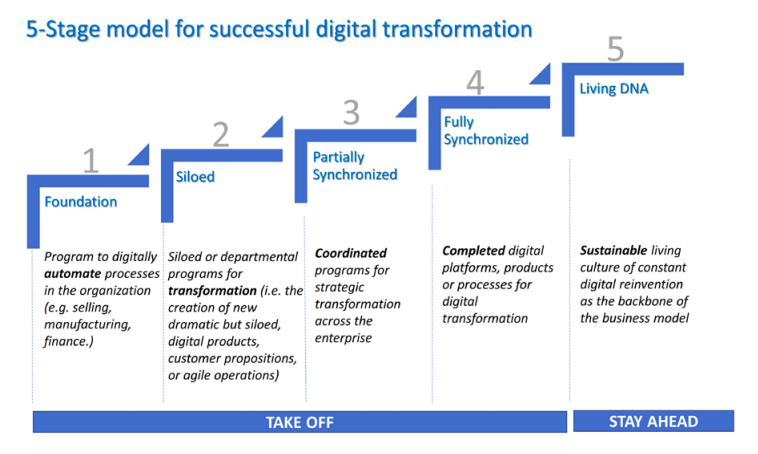
Source: “How To Reverse The Dismal Failure Rate Of Digital Transformations” by Tony Saldanha
Stage 1 – Building the foundation from the ground up
Digital transformation needs to start through providing the right foundation, i.e. digitizing assets and embracing digitalization.
Companies at this stage seek to automate internal processes by using software – for example, using such solutions like HubSpot or Salesforce as the company’s CRM. As mentioned by Saldanha, if you want to minimize manual work and become a digital organization, automating processes by using the right digital tools is indispensable.
Stage 2 – Siloed
The next stage is when individual functions or departments start leveraging technologies to optimize operations, or to experiment with previously unknown business tactics.
Your Customer Support department might, for instance, start using a new tool to analyze customer satisfaction, or your finance department might shift to new fintech solutions to simplify international transfers.
However, at this stage, such changes are limited to single business units. Hence, they don’t influence the entire company, and each department might still run things their own way.
Stage 3 – Partial Synchronization
Companies enter this state after the C-level suite has decided to push the entire organization into the digital era.
This means that various departments or internal processes are being run in a cohesive manner.
Despite these efforts, however, there isn’t a single framework or playbook that would define what digital transformation entails for the organization. The previously mentioned culture of experimentation and continuous improvement is also lacking at this stage.
In order for digital transformation to spread to all departments, a cross-organizational strategy needs to be implemented to dictate the guidelines all business units need to follow.
Stage 4 – Full Synchronization
Stage 4 is achieved once digital transformation is in the company’s bloodstream and all guidelines are clear for all departments.
Nevertheless, the work isn’t entirely done yet. Stage 4 is like taking a new employee on a trial period – only after it has become an integral, stable part of business, can the process be fulfilled.
Stage 5 – Living DNA
The last stage in Saldanha’s model is the point when an organization places digital transformation strategy at the core of its overall business strategy.
This constitutes methods, tools, and capabilities of the company to reliably identify risks and opportunities for disruption as well as repeatedly react to them in a disciplined manner.
At this final, desirable stage of digital transformation maturity, the digital-first philosophy is also clearly apparent in the company culture and engraved in its mission.
Now that we’ve discussed the steps, let’s discuss the benefits of digital technology and why digital transformation is of such critical value for today’s businesses.
Why does digital transformation matter?
Before we proceed with further discussion, it's worth explaining why digital transformation matters.
Why digital transformation is important
Digital transformation is crucial for business growth – it gives organizations an opportunity to “unlock even more potential” by enabling them to scale up effectively, reaching new customers with minimal operational overhead, starting from finance, marketing, all the way through customer service.
As digital transformation can have a dramatic influence on improving the effectiveness of business operations, deciding not to go through it is a recipe for a disaster.
Customers become more demanding. They anticipate the same kind of tech experience in a professional setting as they have in their personal lives.
This is extremely difficult to achieve without going through digital transformation. Creating a great user experience is an important aspect. In fact, nearly 50% of companies interviewed by PwC said that boosting customer experience and satisfaction were the main reasons for starting digital transformation.
What are the benefits of digital transformation?
Digital transformation has the power to bring businesses to a whole new level. Here are a few benefits associated with it:
Actionable insights from data
Imagine what happens when you digitize your business operations – you get access to tremendous amounts of data. You can track all kinds of metrics, like process effectiveness, funnel conversion rates, customer lifetime value, customer satisfaction and many others.
Not only does it allow you to have your data nicely organized and easily accessible, but it also lets you base your decisions on data. This in turn eliminates guesswork, reduces errors and as a result boosts your organizational performance through increasing ROI.
Enhanced customer experience
According to Accenture, 91% of customers are more likely to purchase from brands that call them by their name, know their purchase history, and offer product recommendations based on their preferences. To put it shortly – customers demand personalization, and it cannot be achieved at scale without going digital.
Digital technologies can give you an insight into your customers’ historical data, including their interactions, interests, and engagements.
Furthermore, they provide means to analyze this data on the fly to personalize the customer experience in order to better meet your clients’ needs and expectations.
Increased collaboration across departments
Digital transformation allows for better and more frequent communication with employees across the entire company.
Thanks to the use of online tools like Slack and Trello, not only can co-workers easily share all kinds of information, but they also get a deeper understanding of the processes’ bottlenecks and dependencies, which improves collaboration.
What’s more, it offers companies more cooperation options, like effective remote working, leveraging professional services marketplaces, or delivering projects in multi-vendor distributed environments which would be impossible without digital transformation.
Improved agility and innovation
Digital transformation enables agility and creates more room for innovation. In terms of the main drivers behind going through digital transformation, 68% of companies mentioned agility in the top three, which isn’t surprising. The world’s leaders, including Jeff Bezos, know you can’t effectively operate in this fast-changing market without being agile:
In today’s era of volatility, there is no other way but to re-invent. The only sustainable advantage you can have over others is agility, that’s it. Because nothing else is sustainable, everything else you create, somebody else will replicate - Jeff Bezos, Founder, Amazon
Developing new skill-sets
Introducing new technologies is always followed by the need to acquire new skills and knowledge to master them. Skills that come into play when it comes to digital transformation involve:
- Overall digital literacy;
- Data analytics and AI-guided decision making;
- System thinking and understanding business models;
- Continuous improvement by using lean and agile methods.
Understanding of these skills’ value attracts a lot of interest from the most talented members of the workforce, but at the same time companies find it challenging to recruit employees with these skills. Research by PwC states that 80% of CEOs are concerned about not being able to find talent with the right digital skills.
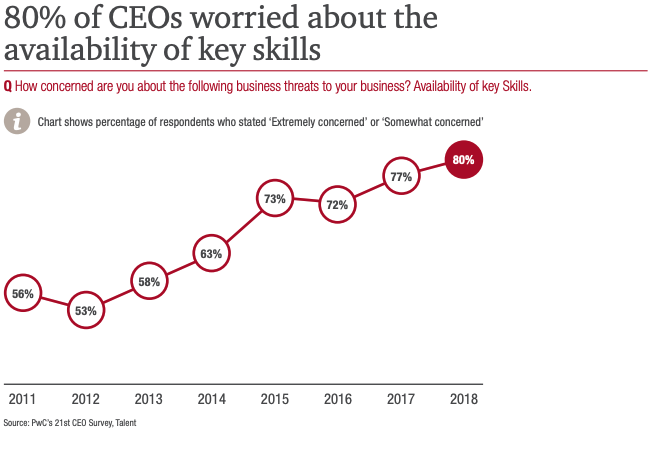
Source: PwC
By embracing digital transformation, companies can encourage their employees to develop new skills and better prepare themselves for the future, all the while supporting their business with the in-house expertise that will help them maintain business growth and a competitive edge.
Enhanced operational efficiency and lower costs
Digital technologies are not only exciting; they also translate into real-cost savings.
Let’s take virtual reality: it enables employees to test and review new processes or products without the need to build them first, as they rely on digital visualizations.
Meanwhile, the issue of data storage can be addressed by cloud computing and can be managed by external vendors. This gives your employees more time to focus on projects which bring more business value and worry less about data storage.
Overall, by introducing digitization you can automate tasks and processes which were previously done manually, and were very time consuming, for example:
- Customer data collection,
- Account changes,
- Status updates,
- Procurement,
- Tech support ticket management,
- Invoicing,
- Time tracking,
- Payroll.
This will have a positive impact on productivity and improve employee satisfaction, as they will no longer have to perform monotonous tasks and will be able to better use their skills.
That being said, let’s proceed to taking a look at a few digital strategy examples.
Examples of Digital Transformation
We mentioned that digital transformation benefits the entire organization. Let’s take a look at a few examples of digital transformation across different departments, starting with marketing.
Examples of digital transformation in marketing
The main motivation for marketing digitization is plain and simple – to reach more customers at a lower cost. How does it work exactly?
Effective digital marketing helps you generate more quality leads and build a better relationship with your prospects and your long term customers. Digital marketing materials can be produced faster and more cheaply than those in print and they’re also easier and quicker to distribute.
What’s more, digital marketing introduces you to the world of automation and marketing analytics and lets you communicate with your customers and leads in a way that was not possible in the analog reality.
This includes chatbots, webinars, social media, and others. Marketers are given a plethora of options to choose from that enable them to design more personalized customer journeys, instead of focusing on a one-size-fits-all approach.
Using marketing analytics lets you track user/customer behaviour and adjust your actions based on the collected insights to create a better, i.e. more personalized, customer experience.
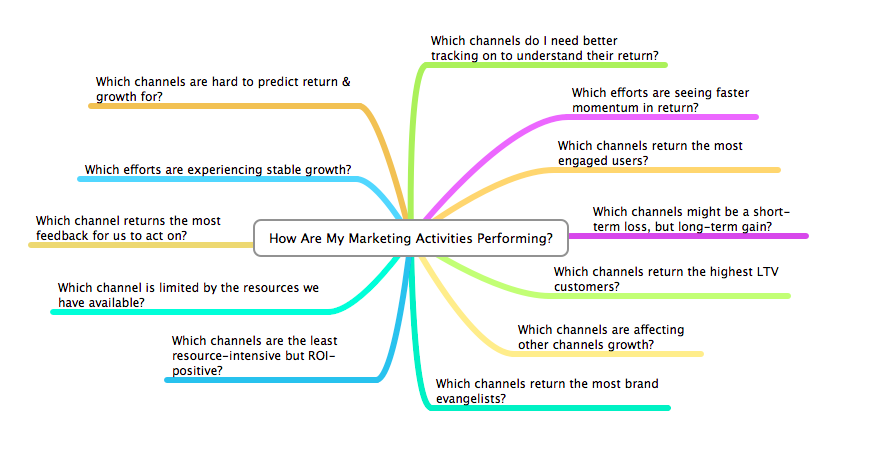
Source: Moz
Effective marketing requires you to be where your customers and leads are. Thanks to digital transformation, marketers can connect with customers using various digital tools and multiple touchpoints including:
- Email: Transactional, promotional, and 1-to-1 emails;
- Mobile Messaging: SMS, push, and group messaging;
- Mobile App Development: Loyalty and e-commerce apps;
- Social Media: Listening, analysis, publishing, and engagement;
- Advertising: Facebook, Google, and LinkedIn ads;
- Website: Personalized content, offers, and landing pages;
- IoT: In-product messaging;
- Communities: Customer communities, partner communities, and employee communities;
- Customer Service: Integrated customer support and social customer care.
Having more channels to communicate with your prospects, leads, and customers increases your chances of converting prospects into leads and leads into customers.
Examples of digital transformation in sales
The success of marketing and sales hugely depends on good quality data, so no wonder that sales benefit significantly from digital transformation.
The access to large data sets has completely changed their work. They can now build ideal customer profiles based on insights collected using various digital tools like Google Analytics, Intercom, Hubspot and, as a result, target prospects more precisely.
Digital transformation has widened prospecting opportunities and sped up lead generation thanks to the use of Artificial Intelligence and social media.
Buyers spend a lot of time on social media, which makes social selling an effective component of a digital transformation strategy. According to Digital Marketing Institute:
Successful social sellers can be regarded as thought leaders, or even trusted consultants, by prospective customers as they provide value through industry insights, sharing expertise and offering solutions to common consumer questions through creating or sharing insightful content.
It’s something that was hard to imagine in the analog world.
Digital transformation has also positively impacted the quality of cooperation between marketing and sales, making communication easier and more open. They can now access the same data via a CRM which reduces miscommunication.
Marketers use it to better tailor their actions which improves conversion. In turn, salespeople receive more detailed information enabling them to prospect and close more effectively.
Going back to AI, digital transformation has created AI-based sales techniques. AI-based systems can go through large amounts of data and identify patterns that enhance selling – both in terms of sales techniques and strategies as well as customer data.
For example, thanks to AI salespeople can learn which demographics are more keen on the product, and at what times of the year they’re more willing to buy. It also provides more detailed insights on the effectiveness of sales strategies, promotions, product-bundles, etc., all so you can better optimize your sales efforts and focus on what works.
Combining the insights provided by AI with the experience and knowledge of your sales team will create a great sales strategy, which is the ultimate goal of digital transformation for sales.
Examples of digital transformation in customer service
As we already mentioned at the beginning of this article, digital transformation has changed not just internal operations, but also what is expected of companies by their customers.
Forbes nails this societal change by calling it living in an ‘uberized economy’, i.e. being surrounded by on-demand apps that deliver a variety of services upon a single click.
Here’s a great example of how introducing digital processes into a company’s core can influence the perceived quality of customer service:
At a recent World Economic Forum workshop, an executive noted that he can order a $1 million piece of equipment with months of lead time, yet have almost no visibility as to its location in the manufacturing process at any given moment. If he’d order a $10 pizza from Domino’s online, however, he’d know almost to the moment when the anchovies are added. Such digitally enabled experiences have created a new normal for all industries.
If we add social media to the equation, where we expect brands to respond to our queries around the clock, this means one thing – customer engagement is now living up to a new standard.
Responsiveness and transparency (like in the above-mentioned pizza example) have become synonymous to “great customer service”.
The good news is digital transformation creates not just challenges, but also new opportunities for customer service.
Firstly, clients aren’t anonymous – as they become more present in companies’ lives, it’s also easier to understand their satisfaction levels, challenges, goals, and fears. For example, if a company collects user feedback through survey software, the customer service department can become a true gateway for insights that can power all departments.
Survey responses can be analyzed not just by client-facing units like customer service and sales, but also marketing and operations. This is a great example of how an advanced-stage digital transformation looks like, where multiple departments work on the same data and towards the same goals.
Secondly, introducing digital solutions like Machine Learning and AI creates self-service opportunities.
This, in turn, can seriously remove the burden off customer support agents. An AI-powered chatbot automatically responds to common customer queries and provides them with answers to their questions at the expected, flick-of-a-switch speed.
Another benefit of chatbots is that they collect data on the types and frequency of questions asked, which helps fuel customer personas and establish new customer service standard goals.
Companies that did a successful digital transformation
There are many companies thatused digital transformation to leapfrog their competition and are pioneers in the field.
Let’s now take a look at examples of companies that have truly aced their digital transformation and are now leaders of their markets.
Nike
When it comes to digital transformation, Nike’s star is among those that shine the brightest. The company took note of the opportunities new technologies created for retail and focused on boosting their digital presence to outpace competing brands.
Nike updated their e-commerce strategy, which was powered by insights from customer and product analytics. The brand also decided to experiment with digital campaigns on social media, and used insights from online interactions with customers to improve the offline shopping experience.
In fact, Nike made headlines for launching one-of-a-kind concept stores, which blend the digital and physical experience.

Source: Demodern
Betting on digital transformation proved worthwhile for Nike – it paid off in more ways than one.
Most recently it helped the company persevere during the COVID-19 lockdown. Although most brick-and-mortar stores were closed in March 2020, their end of the month results were impressive – Nike stock “soared to 11% in the latest earnings announcements, reflecting an increase in online-order and passing Wall Street estimates”, as reported in a Harvard Business School Digital Initiative case study.
One of the reasons for success in these unprecedented times was the brand’s decision to release free content and services, such as the Living Room Cup fitness challenge, livestream workout sessions, and a library of free workouts in the Nike Training Club and Running apps.
All this would be impossible, if Nike executives hadn’t taken steps to prioritize digital experiences years before.
Microsoft
Microsoft is another example of a great digital innovator that went through global business transformation. The company decided on digital transformation to make sure they’re not outpaced by their competitors. In fact, the tech giant was well aware that brands like Apple and Amazon could seriously harm their business.
Microsoft decided to take matters into their own hands and implemented digital solutions from the ground up, across multiple departments.
Below are three examples of how the company’s sales, HR, and customer service were all impacted.
Microsoft’s sales. The company implemented a customized sales solution called Microsoft Sales Experience (MSX). It leverages data from millions of opportunities from previous years to calculate the probability of winning or losing an account.
This allows sales representatives to adjust their offer individually for prospects and to focus on the most promising accounts. Data from MSX is also used to power the company’s CRM, which is used by other departments.
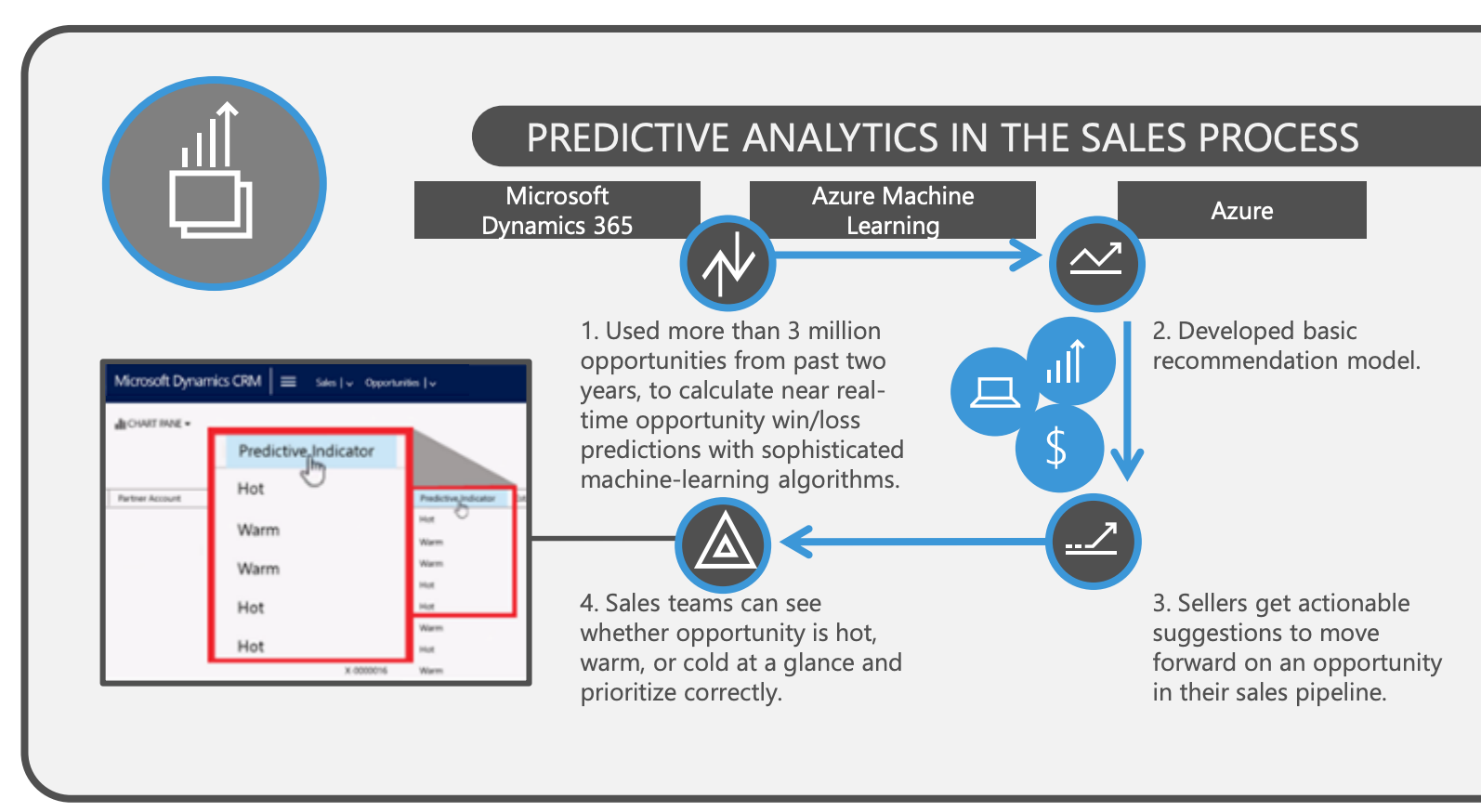
Source: Your Roadmap for a Digital-First Business: Transformation at Microsoft
Microsoft’s HR strategy. The company decided to drive cultural changes by optimizing their approach towards agility, teamwork, and supporting employee performance.
The goal was to attract better tech talent on the competitive landscape. As a result HR Reimagined was created – a solution that analyzes data from thousands of recruitment processes.
Today, Microsoft uses it not just to hire better candidates, but also to reduce recruitment costs and boost employee productivity across other departments.
Optimizing social media communication. Thirdly, Microsoft also decided to reinvent their customer communication online. They build a social listening solution called the Social Command Center to control social media mentions for their 28 brands, including Xbox and OneDrive.
Through monitoring their social media buzz, the company can handle at least 16,000 interactions daily in the United States alone. They also collect what they call a “Niagara falls” or insights on customer sentiment, which can be used to notify relevant departments within the company.
Digital transformation is now so strongly embedded in the company culture that Microsoft is offering it as a service and has also launched a cyclical event – their very own Digital Transformation Academy.
Years after deciding on digital transformation, the company is standing strong, with company stock noting a brief decline in March 2020, but a steady recovery in the months that followed the COVID-19 lockdown.
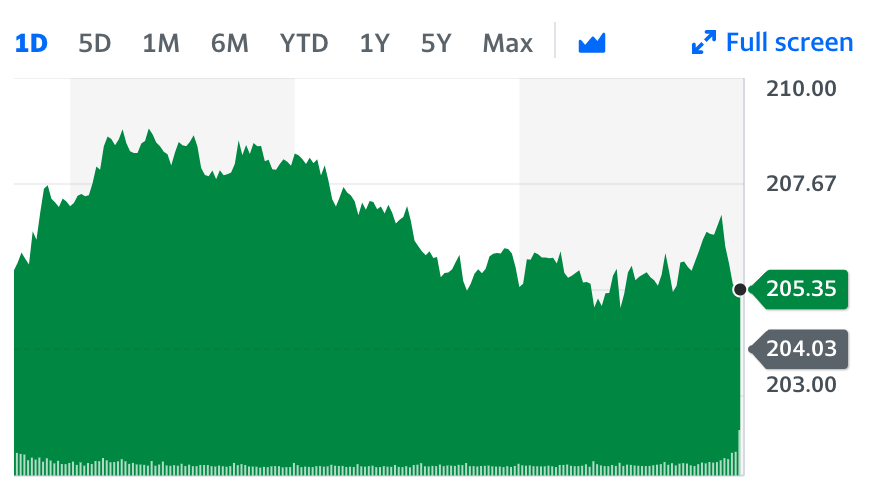
Source: Yahoo Finance
Porsche
Porsche’s main motivation for going through digital transformation was enhancing customer experience. They aimed at making their customer experience as spectacular as their car. They put a lot of time and effort into getting a deep understanding of their ideal customer profile.
Porsche uses a central CRM for storing their customer data, with a unique ID allocated to each data point. Every single customer interaction at every stage of the customer journey is acknowledged and documented.
The collected data and the use of predictive analytics enables the company to more effectively segment their customers which improves their campaign success. For instance, Porsche only gets in touch with customers who already decided they want to buy a car – this results in a higher sales conversion rate.
Porsche has a digital transformation strategy in place called 2025 Plus and in order to meet their goals they set up an Innovation Lab. It is a place where teams of technology and software experts, scientists, and startups get together to discover how innovations such as big data, machine learning, IoT and cloud technologies can be used to benefit the business.
They truly deserve to be called a digital innovator.At Porsche Digital, we are driven by the question of what will complement our business model in the future and how we can optimally exploit the opportunities offered by digital transformation, Stefan Zerweck, Porsche Digital COO.
Home Depot
At the end of 2017, Home Depot decided to spend $11.1 over the next 3 years to transform itself into a more digitally-focused business. This was supposed to result in a revenue increase from $101 billion in 2017 to $115 billion – $120 billion in 2020.
Home Depot’s digital transformation strategy is designed to meet a few objectives:
- Create a seamless customer experience across Home Depot’s various digital assortment and its 2,000 plus brick and mortar stores;
- Reduce internal data silos to get a better overview of customer activity;
- Improve the efficiency of the supply chain.
In order to speed up the entire process, the company hired an extra 1,000 IT staff including software engineers, user-experience designers, and product managers.
They have expanded on their back-end and distribution channels as well as built a robust IT department responsible for collecting customer data and making better use of it. Their efforts paid off as Home Depot is now able to maintain more accurate inventory levels by tracking local trends, which saves them a lot of money.
Digital transformation across various industries
We’ve discussed what digital transformation looked like at different departments and at various companies. Let’s now take a look at it from an industry perspective.
Digital transformation in retail
Digital transformation has dramatically impacted both the retail customer experience as well as in-store and online retail operations.
Many solutions can be seen by customers with the naked eye. Personalized product recommendations powered by AI and Machine Learning, loyalty apps, virtual shopping assistants, and so-called ‘smart mirrors’ in changing rooms are just some examples of digital transformation in retail.
An example that perfectly depicts how technologies are transforming shopping is Amazon Go, which opened its doors in early 2020. It’s the first brick-and-mortar grocery store where customers skip checkout – they simply scan a QR code on their phones upon entrance, pick up the items they need, and leave the store.
To stay relevant to customers, retailers can’t remain passive to digital transformation – especially in the post-COVID-19 reality, where on-site shopping has proven not to be the buyer’s first choice.
As far as operations are concerned, retailers need to experiment with new services and channels to boost customer engagement and brand awareness, and learn how to derive and use insights on their users.
In fact, anyone who wants to be successful in retail needs to transition from a product-centric approach, to an insight-driven model, where customers are provided services where, how, and when they find it most fitting. What’s more, such an approach also creates opportunities for acquiring first-time buyers, for instance, from the older demographic.
Another area which retailers who operate online are trying to address through technology is delivery route optimization (i.e. analyzing the shortest, most cost-effective delivery routes and channels).
Companies are also implementing innovative solutions to manage and optimize stock, logistic chains, and delivery time slots for groceries. These three areas have now become a priority, especially after many top ecommerce players were caught off guard and paralyzed during the COVID-19 lockdown.
Digital transformation in healthcare
Digital solutions are also significantly changing the healthcare landscape. New technologies impact all areas of the industry – from patient experience, through diagnosis and research methods, to administrative and financial procedures.
To understand the impact of digital solutions on healthcare, it’s worth looking at the statistics. Interestingly:
According to a 2019 industry forecast by Meticulous Research, the healthcare IT market is expected to grow at 13.8% CAGR (Compound Annual Growth Rate) between 2019 and 2027, to reach a value of $511 billion.
Here are some of the solutions that are revolutionizing the world of medicine and beyond:
Medical diagnosis and database software
Medical research centers and hospitals alike use these two types of software to generate AI-driven diagnosis hypotheses and to anonymously cross-analyze their assumptions with fellow, external specialists. Such solutions are of growing importance during the COVID-19 pandemic, as they give doctors the ability to discuss common symptoms, treatment plans, and compare cases.
Telemedicine
The market value of telemedicine solution is expected to reach $64 billion by the year 2025 in the United States alone. Software lets healthcare professionals meet with patients online, minimizing the costs and time of commute (and health risks associated with face-to-face examinations). The video conferencing feature is often accompanied by appointment scheduling, e-prescriptions, and billing modules.
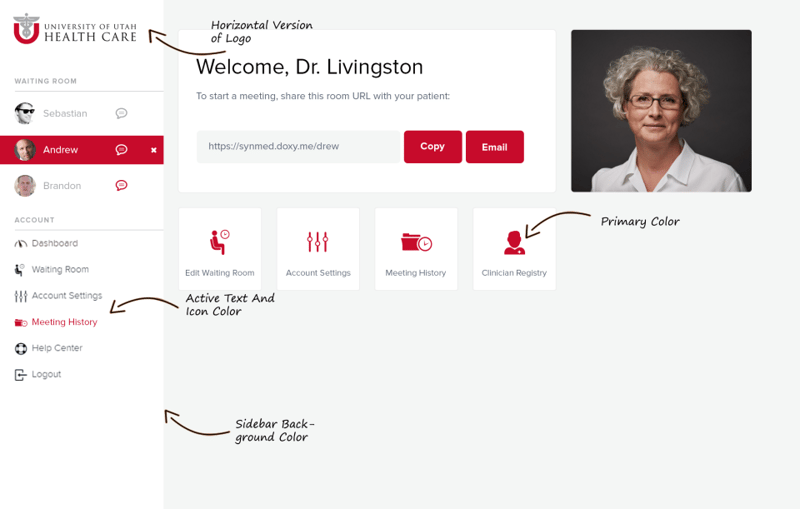
Source: Capterra
Medical equipment management solutions
Equipment maintenance and ordering in the digital era is no longer a tedious task. Thanks toIoT technology, modern medical equipment generates automatic maintenance reports and alerts the right team upon any errors or malfunction.
Medical equipment management solutions also come in the form of inventory software, which lets hospitals control and automatically restock drugs and single-use equipment.
Let’s also not forget about the hundreds of thousands of healthcare apps that are impacting the lives of entire societies, and further setting the new, digital standard expected of healthcare services.
Digital transformation in Banking, Fintech and Insurtech
It won’t come as a surprise if we tell you that digital transformation in banking, fintech and insurtech is also driven by customer experience. It mainly indicates the offering of online and digital services to customers and incorporates a lot of backend modifications to support the shift.
A successful digital transformation at financial institutions requires a holistic approach and must involve digital systems, customer experience platforms, applications, and infrastructure.
Here are a few examples of digital transformation in banking:
- Blockchain technology;
- The use of Artificial Intelligence;
- Customer Data Collection, Management, and Analytics.
Digital transformation in banking, fintech, and insurtech goes way beyond having a website or a digital app, it requires the digitalization of the entire customer journey.
It allows businesses to create a more personal and seamless customer experience by integrating everything into one single platform. Customers are transferred from marketing to sales quickly thanks to online applications for financing through in-app billing.
The path to conversion is shortened: a customer can click on an ad, create an account online, and onboard themselves in the app directly. They can also receive automated loan decisions, pay their bills online, as well as make money transfers without ever visiting the bank.
Furthermore, through digital transformation banks get access to tremendous amounts of data which is especially valuable to marketing and sales.
Marketers can create personalized campaigns, targeting customers who, for example, might be in need of a loan – how so?
Through the use of predictive analytics, which can identify customers who want or need a loan, it can also spot customers thinking of switching banks. This in turn helps with churn reduction as banks can prepare special offers and solutions to stop customers from leaving.
The use of chatbots and AI to automate processes is also part of digital transformation. COIN, a program implemented by JP Morgan, is a great example of it.
It runs on machine learning – it shortens the time it takes to review loan documents and has also helped JP Morgan to reduce the number of loan-servicing mistakes caused by human error.
Digital transformation in the public sector
Governments and governmental agencies worldwide go through digital transformation for two main reasons: to boost citizen satisfaction and to save costs.
The transformation takes place on multiple levels: national, regional, and local and isn’t limited to governments. It also impacts public transportation and national healthcare systems.
Klaus Schwab, Founder and Executive Chairman of the World Economic Forum says that:
As the physical, digital, and biological worlds continue to converge, new technologies and platforms will increasingly enable citizens to engage with governments, voice their opinions, coordinate their efforts, and even circumvent the supervision of public authorities.
The pandemic has further exposed the need to increase digitization and improve technology to enable the continuity of governments.
The COVID-19 outbreak necessitated social isolation and pushed governments and other public institutions into finding ways to keep their citizens informed and safe during the pandemic.
For instance, the NHS allowed patients to order repeat prescriptions via its NHS app – the use of this functionality grew by 111% in March, 2020.
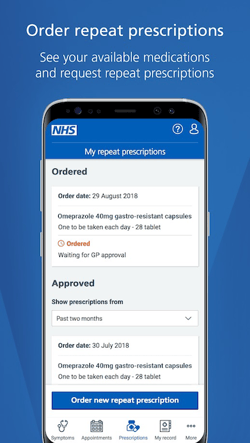
![]()
Source: Pharmacy Business
The UK isn’t the only country that pushes for more digitization. In Estonia, 99% of governmental services can be accessed online.
Citizens have electronic IDs which can be used for managing their healthcare information, attending online courses, paying taxes and even voting in local, regional, and national elections.

Source: e-estonia.com
The Danish government has also made digital transformation one of their key priorities. Now 91% of Danes receive all their government communications through email, and citizens with a nemID (a digital ID) are entitled to paying their taxes online, selecting their phone plan, and even making a hairdresser’s appointment online.
With the increase in online interactions, digital transformation in the public sector is no longer limited to innovation, but it must involve scale management, operational efficiency and deliver taxpayer value for money.
With this in mind, software as a service is a great solution for meeting scalability demands, keeping the costs low and ensuring smooth integration across digital services.
What are the key trends in digital transformation?
What are the main digital transformation trends, which you should pay attention to? We’re going to discuss them now.
Connecting the consumer experience
69% of consumers admit that disconnected customer experience would push them to changing service providers, which, to an extent, explains why 71% of IT decision makers name customer experience as the main reason for going through digital transformation.
There is an increasing pressure on IT departments to deliver connected and personalized experiences for consumers. This issue must be addressed by organizations, and all stakeholders from customers, to partners, employees and developers must take an active part in this transformation.
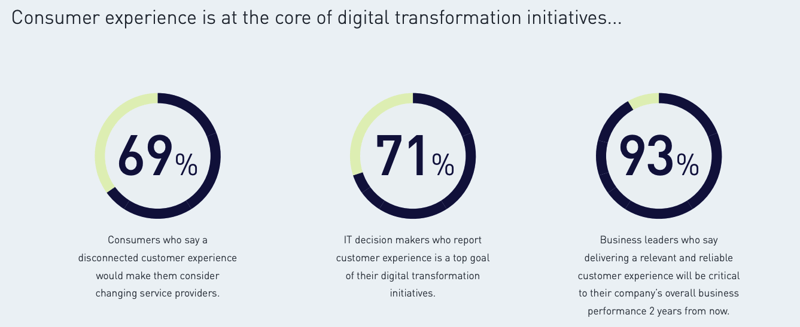
Source: Mulesoft
On average, an organization uses 900 applications. Making sure that all these apps are interconnected is a difficult task, and it’s something that a lot of businesses struggle with.
Customers, however, are demanding and they not only expect a consistent journey across various channels, but they also want their experiences to be personalized.
The definition of “customer experience” is evolving and it now requires more players to get involved: partners, customers, and developers. It can already be observed in retail where the physical and digital worlds are merging – think about the above-mentioned Amazon Go.
AI and Machine Learning bring even more power to data analytics
If you want to make the most of analytics, you should invest in AI and Machine Learning in order to make sense of huge amounts of data and to easily navigate between results. Thanks to the use of these technologies complex data sets can be analyzed in no time – it’s something which was unthinkable a few years ago.
An increasing number of firms is investing in AI to further personalize their customer experience, minimize human bias, and boost productivity. According to a Salesforce’s survey, 42% of companies currently use AI, and an additional 40% plan to use it in the next 2 years.
Prioritizing sustainability
Protecting the natural environment has long stopped being a subject discussed by ecological NGOs, politicians and government, but has also come to the interest of global businesses. Becoming ‘green’ helps to cut expenses and increases attractiveness in the eyes of consumers (as well as potential employees).
This trend falls ideally into digital transformation, as digitized companies often follow the ideals of sustainability. Namely, DT can reduce not just businesses’ operational costs, but also emissions and waste thanks to the use of IoT, AI, and edge computing.
Some examples of how companies that embraced digital technologies practice sustainability include DeepMind AI (used by Google to reduce the organization’s electricity bills) or Phillips’ IoT solutions that helps extend the life cycle of expensive medical equipment, like X-ray machines, by building a new business line of preventative maintenance services.
Embracing a digital culture
While remote work was already a popular trend, COVID-19 has brought it into the mainstream. In order to operate effectively – i.e. without disruption if another lockdown takes place – businesses need to implement processes that prioritize a digital culture for a distributed team. Introducing the right communication and project management tools or a cloud drive to store documents is just the tip of the iceberg!
In order to fully embrace a digital culture, employees must feel a sense of purpose, work towards the same, cross-organizational goals, and develop mutual trust. These are values that can’t be bought.
As discussed in a dedicated piece on digital transformation trends, “without investing in organizational change that empowers employees to act autonomously and take ownership of the decision making process at all levels, there is no successful digital transformation“.
Data at the centre of business
Getting access to more data is one of the main reasons why companies decide to go through digital transformation.
They analyze the findings and use them to improve the customer experience, streamline business operations and to deliver new products and services. Good quality data is the backbone of a highly prosperous business, as decision makers can base their decisions on hard facts instead of guesswork.
In order to unlock the full data potential, it’s necessary to eliminate data silos – 83% of IT decision makers say that data silos create organizational challenges. There is a positive correlation between data integration and business performance.
For example, a retailer called Lane Crawford used APIs (i.e. Application Programming Interfaces) to integrate their customer and inventory data to create a single data-as-a-service platform.
Their customers can now shop new arrivals, view product information by scanning QR codes in store, update their account, and receive order status notifications – all of this improved the customer experience.
Multi-cloud computing
It’s common practice to run on multi-cloud environments, at least as far as modern enterprises are concerned.
This decision is dictated by flexibility – no single platform is able to meet all their workload requirements. Going for multi-cloud computing can be complicated, especially when it comes to moving application workload between cloud environments.
Luckily, it can be addressed using API-led applications development and containerization. According to Capgemini, businesses who have greater confidence in their API and integration capabilities perform better than their competitors in key areas, including revenue growth, innovation, and speed to market.
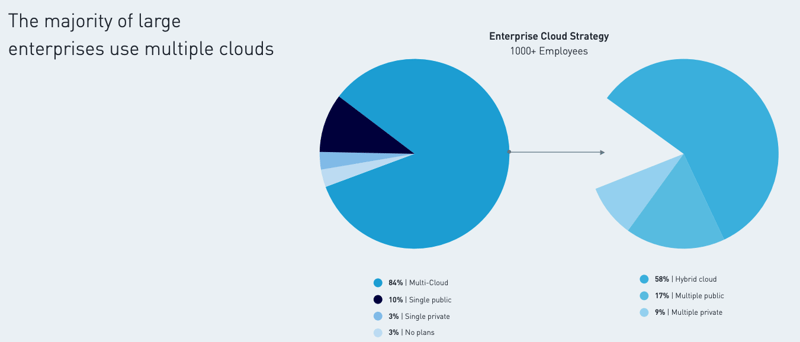
Source: Mulesoft
Cooperating with external partners to create value
Due to the scale and complexity of digital transformation projects, businesses build network effects by engaging with partners, customers, and external stakeholders to create a collaborative ecosystem. McKinsey Digitalclaims that:
An increasing number of industries will converge under newer, broader, and more dynamic alignments: digital ecosystems. A world of ecosystems will be a highly customer-centric model, where users can enjoy an end-to-end experience for a wide range of products and services through a single access gateway, without leaving the ecosystem.
Redistributing revenue across sectors within ecosystems could generate $1 trillion in total economic profit globally.
This makes APIs that link organizations and technologies within ecosystems a crucial capability, which takes us to our next and final trend.
Fueling business performance with APIs
Companies which take advantage of APIs are more productive, have higher revenue growth, and innovate more frequently than those who don’t use APIs. Vala Afshar, Chief Digital Evangelist at Salesforce says:
the API economy unlocks countless new value chains, allowing businesses across nearly every industry to position themselves as platforms for collaboration.
APIs provide a lot of room for innovation and growth, provided that they are managed appropriately. Companies that have a product-like approach to APIs increase their chances of digital business success. Overall, the more advanced the API strategy, the better the business results.
How to lead a digital transformation?
At the beginning of this article, we shared with you the five stages of digital transformation maturity.
Let’s now take a closer look at how you, as a business leader, can help your company develop a digital transformation strategy, where to start, and how to support your employees and organization each step of the way.
Elements of a Successful Digital Transformation Strategy
Know exactly where you want digital transformation to take your business
Before you decide on implementing changes at your company, make sure that they’re rooted in a well-researched, thorough, long-term business strategy. Remember that digital transformation pertains to all business areas, so its goal shouldn’t be improving a single process or department.
When you discuss your digital transformation strategy and its goals, make sure to address the following questions:
- Where and how is your business siloed?
- How much do processes and tools differ among departments?
- Do all your team leaders understand the company mission, business goals, and how their team contributes to them?
- What does communication between teams currently look like? How do teams make sure they’re on the same page with their work and priorities?
- What is the current information and documentation flow at your company?
- How would introducing certain technologies impact all areas of your business (i.e. not just single departments)?
Given the current state of things, can you conduct digital transformation using internal resources only, or should you reach out to external digital transformation partners or new hires?
Base your decisions on insider knowledge
Although your current employees might not be experienced in implementing digital changes, they have the single most important asset – insider knowledge.
If you decide to engage an external contractor to help carry out your transformation, make sure that they have access to your team.
Making the right digital transformation decisions means asking a lot of questions and discussing hypotheses with those who’ve been with your company for a long time.
As noticed by Harvard Business Review, certain decisions made during digital transformation
fail to improve organizational productivity not because of fundamental flaws in the technology but because intimate insider knowledge has been overlooked.
Don’t underestimate customer insights
Ask yourself – why have you decided on digital transformation in the first place?
Certainly, to boost your customers’ engagement, improve their loyalty, and to create experiences that make a lasting impression in the competitive market.
In order to do that, you’ll need to drive your decisions based on insights from your users. As mentioned earlier, you’ll need to shift from a product-centered approach to a customer-driven model.
Depending on your business, you can collect insights from customers by running surveys through the app and/or website, run interviews, or conduct meetings with focus groups.
Now’s the time to dig deep into your customer conversations, check your customer satisfaction scores, and derive information on any customer goals or pain points which transforming your business should fix.
Align the company culture
Ensuring that your employees have a full understanding of the goals of your transformation and actively participate in it is critical to succeeding.
You should commit to transparency and regular communication. Letting your team understand what, how, and why you’re looking to implement can help nurture a culture of focused execution. Not to mention, they’ll feel encouraged to contribute and share their insights!
For instance, when Adobe decided to shift to a subscription-based service business model in 2012, the leaders knew they needed to instate a sense of purpose across the entire team.
In order to achieve that, they decided to put their employees into their customers’ shoes through a program called ‘Experience-a-thon’.
Employees who already had an insider perspective were now able to incorporate a customer perspective into their mindset. As a result, the employees felt a stronger sense of purpose, understood customer goals, and have helped turn the transformation into a full-blown success.
As you can see, the benefits of keeping your employees informed extend well beyond HR and are crucial to your digital transformation success.
Embrace experimentation and rapid decision making
The most disruptive and digitally-enabled companies originated in Silicon Valley (e.g. Google, Salesforce, Apple). What do they all have in common and are famous for?
- Agile decision making;
- Fast prototyping;
- Flat organizational structure.
All of these qualities are necessary for a successful digital transformation – decisions must be made and adjusted fast, and teams from various departments must get on board.
This explains why a traditional hierarchical structure could never work. The best solution is to create a flat organizational structure and separate it from the rest of the business.
Nourish a culture of change
Returning to your old habits and practices will be unavoidable if you don’t make change part of your business mentality. The main goal is to build a culture of continuous innovation, willingness to change, and desire for improvement.
It’s a good practice to ask employees to regularly share ideas for innovation – you can set up an innovation management platform or organize meetings where your peers can talk you through the solutions they came up with.
You can even go a step further and build an innovation team who will be responsible for gathering insights on quality improvement, brainstorming them, and selecting the best ones to take to the management team. That being said, let’s look deeper into the essential roles you’ll need during your transformation.
Essential digital transformation roles
As we’ve already proven in many parts of this article, digital transformation can be a gateway to incredible business success – provided that it’s carried out properly.
In order to ensure a sound transition, many companies decide to hire new employees, transform current roles, or engage external partners to oversee the process and play the key roles in their transformation.
Let’s take a look at the most important players:
Chief Digital Officer (CDO)
In the simplest terms, the role of a Chief Digital Officer is to oversee the digital transition of a business to ensure its growth in the future.
CDOs are hired to generate bold, creative ideas, back them up with data for internal buy-in from C-level executives, and to work alongside other departments to see the implementation through.
In their work, the CDO analyzes internal and external data from multiple sources. Starting from customer insights from client service, through user behavior from product and the IT department, to market trends and reports.
The ultimate metric of a CDO’s success is when they can take a company from point A to point B and instill a digital mentality so strong within the organization that their services are no longer necessary.
After digital transformation is completed, CDOs are often moved to other C-level roles (which depends on the CDO’s skills and company needs).
According to a McKinsey study, “less than one-third of all respondents say their organizations have engaged a chief digital officer (CDO) to support their transformations. But those that do are 1.6 times more likely than others to report a successful digital transformation.”
Chief Innovation Officer (CIO)
Another C-level role often introduced during digital transformation is the Chief Innovation Officer, who works hand in hand with the CTO in the IT department.
Though often confused, CIOs and CDOs aren’ the same – CIOs play a role at the intersection of business and technology, and most often have a strong IT background. Their role is to drive innovation through an understanding of both business goals and technological capabilities of software and infrastructure.
Technology-innovation managers
Technology-innovation managers are often hired to work alongside the CIO or CDO to remove any blockers, such as informational and technical gaps that are keeping departments from embracing a company-wide digital strategy.
Some companies that choose not to hire a CIO or CDO decide on hiring technology-innovation managers to work with operational and IT units.
Integrators
Another important role, integrators work at specific departments to ensure that new digital solutions are soundly implemented by each team.
As integrators provide ideas on how certain processes can be introduced, they are often hired from among candidates who have both business and technology experience (for example, people who have worked as IT Product Managers or Tech Leads).
They are a great asset to each department, as they can explain the technical and strategic importance of a process in simple terms to fellow team members.
These four roles are most often created from scratch when the company decides to enter the digital era. However, a sound digital transformation strategy requires that several other roles are either altered or strongly engaged in the process. These include:
C-level executives: As with other decisions of critical strategic importance, all C-level executives need to be on the same page and agree on company-level changes.
Senior IT employees: Tech leads and senior developers must all be onboarded to propose technical solutions that will leverage various data points and bridge previously-siloed departments.
Human resources professionals: long-term digital success requires a shift in hiring, with certain skills becoming more important than ever. New employees need to have a digital-first mindset, and relevant training needs to be offered to them upon onboarding. As reported by McKinsey, “27 percent of respondents report successful transformations when their companies set cross-functional or enterprise-wide hiring goals based on specific skill needs—nearly twice the share of respondents whose organizations do not”.
Agencies specialized in digital transformation: oftentimes, the best decision a company can make is to hire an external digital transformation partner to guide them through the process. Such agencies have implemented hundreds of successful transformations, so engaging them gives your company access to invaluable insights and years of market experience.
Author: Karolina Przybysz-Smęda
Kuba Filipowski
Kuba Filipowski is the CEO and Co-founder of Netguru, a digital acceleration company. As CEO, he is responsible for overseeing the entire business, facilitating the implementation of the company's strategy, and leading the executive management team. Before assuming his role as CEO, Kuba established and managed Netguru's business development teams. In 2022, as Chief Strategy Officer he coordinated Netguru's M&A efforts, leading to strategic investments in Pilot44 and mohi.to.

Read more on our Blog
Check all the important aspects you need to consider when considering digital transformation in your company.
-

Want Speed? Disruption Leaders Urge: “Stop Telling People What to Do”
-

5 Tech Trends That Drive Digital Acceleration in 2023
-

Tech Leaders in Berlin: Profitable Growth is the Name of the Game Now
-

Don't Listen to Henry Ford! Ask the Users, and Ask Them a Lot
-

To Hell With Normal. Volatile Markets Create Lasting Opportunities
-

No Time to Slow Down: Economic Downturns and Digital Acceleration